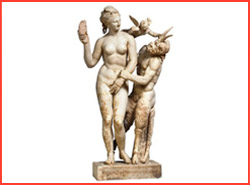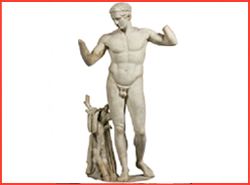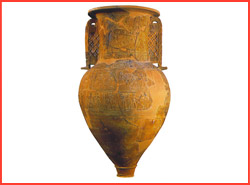Found on Delos,
Aphrodite of Delos, Marble group of Aphrodite with Pan and Eros (About 100 BC)
Aphrodite of Delos with Pan & Eros,the naked goddess of beauty and love is rendered frontally with hair well-combed and tied up by means of a scarf bound in a bow above her parting. The manner in which she bends her left leg lends a gracefulness to her stance. She holds her left hand in front of her pubic triangle which she is trying to cover or protect with her palm from the indiscreet intentions of the philanderer Pan, while she brandishes her sandal in her raised right hand in an attempt to deter him. The goat-footed, horned god has seized her left wrist with his sinewy left hand. He leans on a tree trunk covered with an animal’s skin and has left his hunting stick (lagobolon) at the foot of the tree. The little, winged son of Aphrodite, Eros, is trying to repulse Pan by grasping his right horn. On the low base of the group an inscription is carved ‘Dionysos, son of Zenon who was son Theodoros, from Beirut dedicated [this offering] to the ancestral gods for his own benefit and that of his children’.
Aphrodite of Delos with Pan & Eros,the marble group was found on the island of Delos in 1904, in a room (N) of the Hall of the Guild of the Poseidoniasts (that is, worshippers of the god Poseidon) from Beirut. According to the inscription above the west columns lining the big court of the building , the members of this club were tradesmen, shipowners and warehousemen. The architectural remains and movable finds from the structure dating to the first half of 2nd cent. BC reveal that it served as a sanctuary, since it possessed rooms reserved for the cult of Rome, Poseidon, and, probably, Astarte, as a commercial headquarters and as an accommodation for casual merchants. A Roman was involved in its erection, according to a decree of the guild of the Poseidoniasts dated to 153/152 BC. The building was damaged in 88 BC when the troops of Mithridates VI the Eupator, the king of Pontus, attacked the island during his war against the Romans and was never repaired after the sack of the island by pirates, allies of Mithridates, in 69 BC.
Delos was declared a free port by the Romans in 166 BC and soon became a hub for Greco-Roman transactions and a cosmopolitan centre. The numerous public and private buildings on the island were decorated with sculpture and thanks to demand for their services artists from Athens and Asia Minor moved to the island. The variety of sculptural examples from the Hall of the Poseidoniasts, which include statues of Rome, Poseidon, an image of Hekate, statuettes of Herakles Epitrapezios (= ‘seated at a table’) and of Aphrodite of the Arles type, bronze busts of merchant benefactors and culminate in our group of Aphrodite with Pan and Eros show the tastes of Asian tradesmen and a whimsical, slightly erotic mood alongside a more austere, traditional trend and certain classicizing pieces.
Aphrodite of Delos
Aphrodite of Delos with Pan & Eros
Bibliography: Α. Stewart, Greek sculpture, New Haven-London 1990, 56-58, 226-228. Ν. Κaltsas, Sculpture in the National Archaeological Museum, Αthens 2002, 294-295 no. 617. Ph. Bruneau and J. Ducat, Guide de Delos, Paris 20054, 227-231.
About 100 BC
Height (base included) 1.55m
From Delos, House of the Poseidoniasts of Beirut
Exhibition Room: National Archaeological Museum inv. no. 3335, Room 30






